Term 1 Unit 4 | History | 7th Social Science - The Delhi Sultanate | 7th Social Science : History : Term 1 Unit 4 : The Delhi Sultanate
Chapter: 7th Social Science : History : Term 1 Unit 4 : The Delhi Sultanate
The Delhi Sultanate
Unit –IV
The Delhi Sultanate
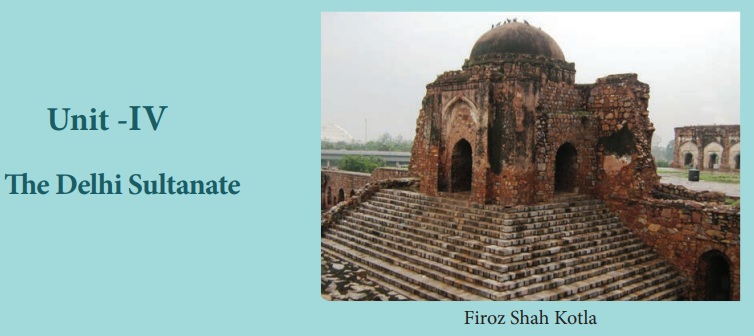
Learning Objectives
To
acquaint ourselves with
•
Turkish Sultans of various dynasties who ruled India from Delhi
•
Their military conquests and extension of sovereignty
•
Administration of the Delhi Sultanate
•
Art and architecture of this period
Introduction
During
the eleventh century, the Turkish horsemen pillaged northern India and due to
their persistent campaigns, they succeeded in seizing political control of the
Gangetic plain by the next century. Though the success of their conquests could
be attributed to their audacity and ferocity, their success is really due to
the failure of Indians to defend themselves and their territories. Indians
viewed each other with distrust, failing to take note of the success of Islam
in early years of its spread. The superior military might of Muslim soldiers
was yet another factor that contributed to success in their conquests. In this
lesson, we discuss how Turkish warriors set about founding and consolidating
their Islamic rule till the advent of Babur.
Slave Dynasty (1206 -
1290)
Muslim
rule in India was established by Muhammad Ghori in 12th century A.D. (CE). As
he had no sons, he nurtured special slaves called bandagan (a Persian
term used for slaves purchased for military service). These slaves were posted
as governors and they were later raised to the status of Sultans. After Ghori’s
death in 1206, one of his slaves Qutb-ud-din-Aibak who had been left behind by
Muhammad Ghori to govern the territories he had conqured, proclaimed himself
ruler of the Turkish territories in India. He laid the foundation of the Slave
Dynasty. This dynasty is also known as Mamluk dynasty. Mamluk is an Arabic word
meaning ‘‘slave’’. Qutb-ud-din-Aibak, Shams-ud-din-Iltutmish and
Ghiyas-ud-din-Balban were the three great Sultans of this dynasty. The Slave
Dynasty ruled over the sub-continent for about 84 years.
Qutb-ud-din-Aibak (1206 -
1210)
Qutb-ud-din-Aibak
began his rule by establishing Lahore as the capital of his kingdom. Later he
shifted his capital to Delhi. He was active all through his rule in Delhi
conquering new territories and suppressing rebellions. He personally led
military campaigns to the central and western Indo-Gangetic plain (north India)
and left the conquest of the eastern Gangetic Plain (Bihar, Bengal) to the care
of Bakhtiar Khalji. Aibak built the Quwwat-ul-Islam Masjid (mosque) in Delhi.
This mosque is considered to be the oldest in India. He also laid the
foundation of the Qutb-Minar, but he was unable to complete it. It was later
finished by his son-in-law and his successor Iltutmish. Aibak died of injuries
received during an accidental fall from a horse, while playing polo in 1210.
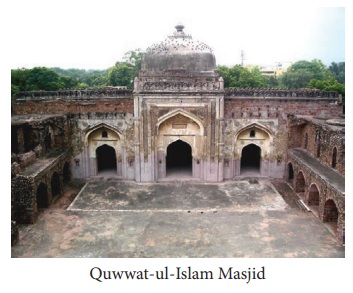
Iltutmish (1210 - 1236)
Aibak’s
son Aram Shah proved incompetent and so the Turkish nobles chose Iltutmish, the
son-in-law of Aibak as the Sultan, who served as a military commander of Aibak.
Iltutmish firmly established his control over the territories
by
suppressing rebellions. It was during his reign that the threat of Mongols
under Chengiz Khan loomed large over the frontiers of India. He averted the
impending danger by refusing to provide shelter to the Kwarezm Shah
Jalal-ud-din, who had been driven out by Chengiz Khan. In order to counter the
possible attack of the Mongols, Iltutmish organised Turkish nobility into a
select group of 40 nobles known as chahalgani or The Forty.
Iltutmish
granted iqtas (land) to members of his army. Iqta is the land granted to
army officials in lieu of a regular wage. The iqta holder is called the iqtadar
or muqti who had to provide the Sultan with military assistance in times of
war. The iqtadar collected revenue from his iqta to meet the cost of
maintaining his troops and horses.
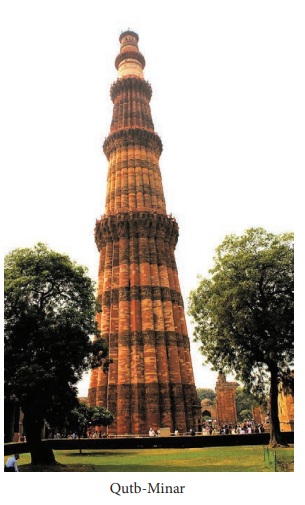
Iltutmish
completed the construction of the Qutb-Minar, which had been started by Aibak.
Iltutmish died in April 1236 after ruling for 26 years.
Razia (1236 - 1240)
As
the most capable son of Iltutmish, Rukn-ud-din-Firuz, was dead, Iltutmish
nominated his daughter Razia Sultana as his successor to the throne of Delhi.
Razia was an able and brave fighter. But she had a tough time with Turkish nobles
as she favoured non-Turkish nobles. She also faced the situation of the
ferocious Mongols raiding Punjab during her reign.
Razia
made an Ethiopian slave named Jalal-ud-din Yakut as her personal attendant and
started trusting him completely. This led to a revolt of the Turkish nobles who
conspired against her and got her murdered in 1240.
Ghiyas-ud-din Balban
(1266 - 1287)
After
Razia, three weak rulers in succession ascended the throne. After them came
Ghiyas-ud-din Balban. Balban abolished The Forty as it was hostile to him. He
established a department of spies to gather intelligence about the conspirators
and the trouble makers against his rule. He dealt with insubordination and
defiance of royal authority sternly. Tughril Khan, a provincial governor in
Bengal, who raised a banner of revolt against Balban, was captured and
beheaded. He was ruthless in dealing with enemies like Meos of Mewat (a Muslim
Rajput community from north-western India). Balban, however, took care to
maintain cordial relationship with the Mongols. He obtained from Hulagu Khan, a
grandson of Chengiz Khan and the Mongol viceroy in Iran, the assurance that
Mongols would not advance beyond Sutlej.
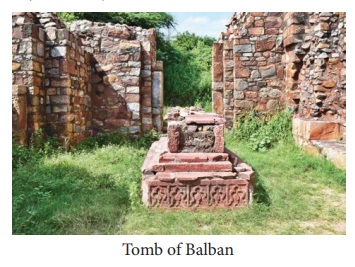
Balban
built forts to guard his empire against the Mongol attacks. He patronised the
famous Persian poet Amir Khusru. Balban died in 1287. Balban’s son Kaiqubad
turned out to be weak. In 1290 Malik Jalal-ud-din Khalji , the commander of the
army, assumed the office of Naib (a deputy to the Sultan) and ruled the kingdom
in the name of Kaiqubad. Then one day, Jalal-ud-din sent one of his officers
and had Kaiqubad murdered. Jalal-ud-din then formally ascended the throne. With
him began the rule of Khalji dynasty.
Khalji Dynasty (1290 -
1320)
Jalal-ud-din Khalji (1296
- 1316)
There
were many military campaigns during the reign of Jalal-ud-din. But they were
mostly organised and led by his nephew, Ala-ud-din, the governor of Kara. One
significant military expedition was against the Deccan kingdom Devagiri. Ala-ud-din,
after defeating the Yadava king Ramachandra, plundered the city and returned
with huge wealth. Ala-ud-din treacherously killed Jalal-ud-din after buying off
the prominent nobles and important commanders with the wealth he had brought
from the Deccan and declared himself as the Sultan of Delhi in 1296.
Ala-ud-din Khalji (1296 -
1316)
Ala-ud-din
Khalji consolidated the Delhi Sultanate. The range of his conquests is
impressive: in the Punjab (against the Mongols), in Rajasthan and in Gujarat.
With his northern frontiers secure, he sent his chief lieutenant Malik Kafur
into the southern parts who took even the distant Madurai in 1310. The Yadavas
of Devagiri, the Kakatias of Warangal, the Hoysalas of Dwarasamudra and the
Pandyas of Madurai accepted Ala-ud-din’s suzerainty.
Sack of Chittor
(1303): When Ala-ud-din’s
army overwhelmed the Rajput army in Chittor and in the context of threat of
defeat, the men and women of the fortress, in accordance with their old custom,
performed the rite of jauhar. According to this custom, left wit no other way
to survive, the men would go out and die in the field of battle and women would
burn themselves on a pyre.
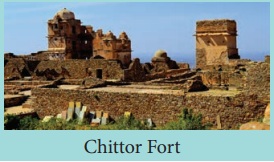
Ala-ud-din’s
political and administrative reforms were as impressive as his military
conquests. Ala-ud-din undertook a survey of the agrarian resources around his
capital and fixed a standard revenue demand. He entrusted the task of
collecting the revenue to the military officers. This measure deprived the
local chiefs and rajas of their time memorial privilege. Ala-ud-din established
a system of forced procurement of food grains for Delhi and other garrison
centres. The procurement prices were fixed and grain collected as tax was
stored in state granaries. In order to ensure the enforcement of his new
regulations, he employed spies who were responsible to report to him directly.
Ala-ud-din
died in 1316. The failure of his successors to retain power led to the seizure
of power by Ghiyas-ud-din Tughluq, who founded the Tughluq dynasty.
Tughluq Dynasty (1320 -
1324)
One
of the major tasks of Ghiyas-ud-din as the Sultan was to recover the
territories that the Sultanate had lost during the turmoil following the death
of Ala-ud-din. Ghiyas-ud-din Tughluq sent his son Jauna Khan to fight against
Warangal. Jauna Khan defeated Pratabarudra of Warangal and returned with a rich
booty. With this looted wealth, Ghiyas-ud-din is said to have laid the
foundation of the city Tughluqabad near Delhi. However, as Ala-ud-din
treacherously killed his uncle, Jauna Khan was said to have killed his father
and ascended the throne with title Muhammad-bin-Tughluq in 1325.
Muhammad-bin-Tughluq
(1325 - 1351)
Muhammad-bin-Tughluq
was a learned man. Yet he was a person of cruelty. Ala-ud-din had conquered,
looted and left the old ruling families as his dependents. In contrast,
Muhammad Tughluq dreamt of making the whole of the subcontinent his domain.
With the view to facilitating extended
sovereignty, he shifted his capital from Delhi to the centre of the kingdom, namely
Devagiri. He also changed its name to Daulatabad. When Muhammad himself decided
that the move was a mistake, he ordered a return to Delhi as the capital again.
When Ibn Battuta, the Morocco traveller who was with the Sultan, returned to
Delhi, he found Delhi ‘empty, abandoned and had but a small population’.
It was a 40-days march to Daulatabad from Delhi. Many people
left. Some hid themselves. When they were found, they were punished cruelly,
even though one was a blind man and another a paralytic. Describing the city as
spreading over eight or ten miles, a historian observed: ‘All was destroyed. So
complete was the ruin that not a cat or a dog was left among the buildings of
the city in its palaces or in its suburbs.’
Tughluq
changed the Ala-ud-din’s system of revenue collections in grain and ordered
that land revenue, which was increased, should henceforward be collected in
money. This proved disastrous during famines. When he discovered that the stock
of coins and silver was inadequate for minting, he issued a token currency in
copper. Counterfeiting soon became order of the day and, as a result, the
entire revenue system collapsed. Trade suffered as foreign merchants stopped
business. This forced Sultan to withdraw the token currency and pay gold and
silver coins in exchange. This move led the state to become bankrupt. Tughluq
increased land tax in the Doab region, which triggered peasant revolts. As the
revolts were cruelly dealt with, peasants abandoned cultivation, which resulted
in the outbreak of frequent famines.
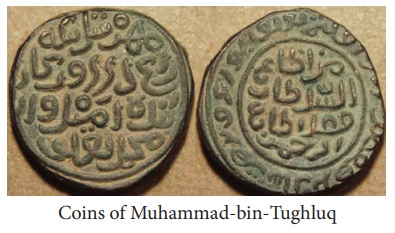
Tughluq
ruled as Sultan for 25 years. During his long reign, he had to face many
revolts of the provincial governors. The Governors of Awadh, Multan and Sind
revolted and declared themselves independent. In South India, several states
arose. The new Daulatabad and the conquered territories around them were
declared independent sultanate called Bahmani. Its founder after whom it was
named, was a soldier formerly in Tughluq service. Madurai was proclaimed a
separate sultanate in 1334. Bengal became independent in 1346. Tughluq died on
23 March 1351.
Firoz Shah Tughluq (1351
- 1388)
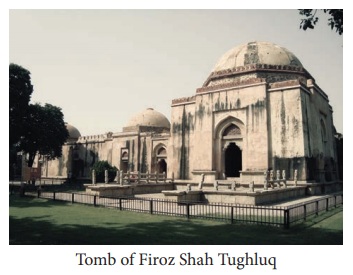
Firoz,
the son of Ghiyas-ud-din’s younger brother, succeeded Muhammad-bin-Tughluq.
Firoz could neither suppress revolts nor win back the provinces that had broken
away. He also showed no interest in re-conquering the southern provinces. He
refused to accept an invitation (c. 1365) from a Bahmani prince to intervene in
the affairs of the Deccan. Firoz rewarded Sufis and other religious leaders
generously and listened to their advice. He also created charities to aid poor
Muslims, built colleges, mosques, and hospitals. He adopted many humanitarian
measures. He banned inhuman punishments and abolished taxes not recognised by
Muslim law.
He
promoted agriculture by waiving off the debts of the agriculturalists and
constructing many canals for irrigation. He laid out 1200 new gardens and
restored 30 old gardens of Ala-ud-din-Khalji. He had built new towns such as
Firozabad, Jaunpur, Hissar and Firozpur.
Despite
adopting a peaceful approach and taking efforts to organise the Sultanate well,
he had to spend his last days in unhappiness. His own son Muhammad Khan
revolted against him and Firoz Shah died in September 1388, at the age of 83.
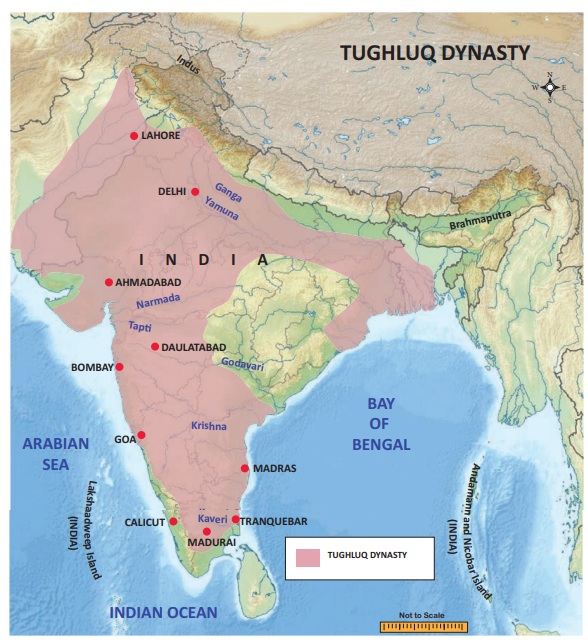
Timur’s Invasion (1398)
The
sacking and massacre by Tamerlane or Timur of Delhi came a decade after Firuz
Shah Tughluq died. As a ruler of the region around Samarkand in Central Asia,
Timur had occupied some parts in the north-west of India. Taking advantage of
India’s weakness, he entered India in December 1398 and plundered Delhi.
Punjab, besides the Delhi city, was the province that suffered most by Timur’s
raid. Timur, apart from carrying huge wealth in the form of gold, silver,
jewels, also took along Indian artisans like carpenters and masons to work on
monuments in Samarkand.
Sayyid Dynasty (1414 -
1451)
Though
the Sultanate fragmented into a number of independent kingdoms, it endured for
114 years more, till the Mughal invasion. Before leaving Delhi, Timur had left
behind his representative
Khizr Khan as the governor of the territories he had conquered (Delhi, Meerut
and Punjab). He founded the Sayyid Dynasty in 1414, which lasted till 1451. The
last ruler of this dynasty, Ala-ud-din Alam Shah, abdicated the throne in 1451.
This gave Bahlol Lodi, then the governor of Sirhind (Punjab), the opportunity
to become the new Sultan of Delhi, leading to the establishment of Lodi
dynasty.
Lodi Dynasty (1451 -
1526)
In
1489, Bahlol Lodi was succeeded by his son Sikandar Lodi. Sikandar was a patron
of arts and learning. He founded the city of Agra and made it his capital. He
died in 1517 and was succeeded by his son, Ibrahim Lodi, who was defeated by
Babur in 1526 in the Panipat battle. Thus the Lodi dynasty and the Delhi
Sultanate were ended by Babur who went on to establish the Mughal Empire in
India.
Islamic art and architecture: The
mansions of high-ranking Muslim nobles, soldiers and officials were
built first in cities and the neighbourhoods. Around them, the mosques in the
imperial style were constructed by successive Muslim regimes in Delhi. Mosques
and Madrasas looked architecturally different. The graceful decorations of
doorways and walls with lines from the Koran made a distinct appearance in
these buildings. The shape of all these buildings was Persian, while the
decoration was Indian. So, it is called Indo-Saracenic architecture. Qutb
Minar, Alai-Darwaza, Quwwat-ul Islam Masjid, Moth-ki-Masjid, the tombs of
Iltutmish, Balban and the forts of Daulatabad and Firozabad were all
constructed in this style.
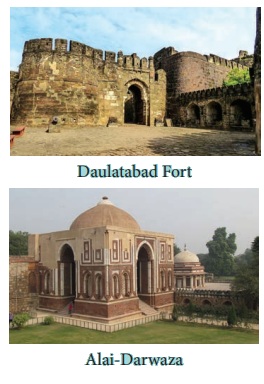
Summary
•
Establishment of Muslim rule in India by Muhammad Ghori
•
Slave dynasty founded by Qutb – ud- din- Aibak and consolidated by his
Son-in-law Iltutmish Razia, the daughter of Iltutmish, a brave fighter and a
great administrator
•
Balban’s espionage system and the abolition of The Forty, to reduce the power
of Turkish nobles
•
Ala – ud- din- Khalji as the founder of Khalji dynasty - his military conquests
and administrative reforms
•
Firoz Shah Tughluq as a compassionate ruler with his concentration on the well
- being of the people
•
The sacking of Delhi by Timur
•
Khizr Khan founding the Sayyid dynasty and Bahlol Lodi the governor of Sirhind
establishing the Lodi dynasty
•
The first battle of Panipat paving the way for the foundation of Mughal Empire
by Babur in A.D. (CE)1526
Glossary
1.
impending: about to happen எக்கணமும் நடைபெற
இருக்கிற / அச்சுறுத்தும் நிலையில் இருக்கிற
2.
ferocious: cruel, violent மூர்க்கமான/ அச்சம் தருகிற
வகையில்
3.
conspirator: someone
who conspires secretly with other people to do something unlawful or harmful சதிகாரர்கள்
4.
patron: supporter, promoter புரவலர்
5.
plunder: to steal goods
forcibly from a place especially during a war கொள்ளையடி
6.
procurement: the
process of getting supplies கொள்முதல்
7.
disastrous: causing
great damage பேரழிவு
8.
fragment: break into pieces துண்டு துண்டாக
9.
counterfeit: fake போலியான
10. waiving: exempting விலக்கு அளி
References
1. Abraham Eraly, The Age of Wrath, New
Delhi:Penguin, 2014.
2. R.C Majumdar, H.C. Ray Chaudhuri and
Kalikinkar Datta, An Advanced History of India, New Delhi:Trinity, 2018.
3. Burton Stein, A History of India,
New Delhi: Oxford University Press, 2004 (Reprint).
4. S.K. Singh, History of Medieval
India, New Delhi: Axis Books, 2013.
ICT CORNER
The Delhi Sultanate (A.D.
(C.E)1206–1526)
Through this activity you
will k about the Timeline of medieval period in Delhi

PROCEDURE
:
Step 1: Open the Browser and type the URL given
below (or) Scan the QR Code.
Step 2: Keep Scrolling and go to ‘Timeline
Step 3: Click any period and you can explore
the historical events with pictorial descriptions (ex. Delhi Sultanate)

The
Delhi Sultanate (A.D. (CE)1206–1526) URL:
https://delhi-timeline.in/
(or) scan the QR Code
*Pictures
are indicative only
*If
browser requires, allow Flash Player or Java Script to load the page.
Related Topics